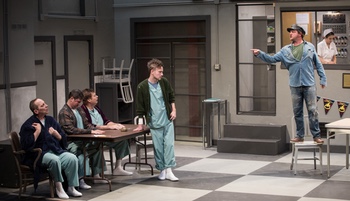
Through Sun 10/8
The Beck Center production of Ken Kesey’s One Flew Over the Cuckoo’s Nest combines a stage full of brilliant actors to produce a moving drama that does exactly what good theater should do: inspire empathy and reflection.
William Roudebush has taken Dale Wasserman’s stage adaptation of Kesey’s novel and turned it into an immersive, fast-paced recreation of Kesey’s novelistic early 1960s rant against ruthless and controlling social mechanisms (in this case the deadly combo created by courts and asylums). Randle P. McMurphy (Bryant Carroll) has been committed to an Oregon psychiatric hospital by the courts. Carroll brilliantly creates the rash protagonist, making him physically dangerous (prone to hit, move quickly), rebellious, naive (about the law), fun-loving, considerate and compassionate — all at once. (And it doesn’t hurt that he looks a bit like Ken Kesey.)
The ward McMurphy happily enters (at this point he thinks he can just leave and that he’s ducked prison work-crew duty) is filled with inmates who move like zombies — men who have had all personality either beaten or drugged or electroshocked out of them. Nurse Ratched (a very persuasive Katie DeBoer who makes us love to hate her) runs the ward with an iron fist, all the while dripping fake smiles and kindly gestures. McMurphy ignores cautions about irritating Nurse Ratched and he’s very good at it — until he isn’t.

As the story continues we learn there’s a big difference between electroshock therapy (you don’t want it, it hurts, but you recover) and a prefrontal lobotomy (essentially castrating the brain), an experimental procedure that began in the 1940s. (John F. Kennedy’s sister Rosemary Kennedy had one with famously disastrous results.)
Nurse Ratched controls through running demoralizing “group therapy” sessions that end by her invitation for the others to “pile on” the person under consideration. Later, McMurphy points out to them that this it wrong; it’s the way chickens peck to death injured birds and then attack the birds who got blood spattered.
Kudos to the other players in the ward with him. Each manages to make us see vividly both their illness and their positive response to kindness. Maurice Cole (who towers over everyone at almost seven feet tall) does an outstanding job as the ultimately heroic Chief Bromden, a Native American who seems to be in a catatonic state when the drama opens. We see him watch migrating birds and suspect there may be more to the Chief than he lets on, all thanks to Cole’s expressive body language.
Inmates with major plot lines include the shy, suicidal virgin Billy Bibbit (an artful Jeremy Gladen) and unofficial group leader Dale Harding (masterfully drawn by George Roth). Others, all persuasive in the roles as “acutes” (and possibly curable), include Cheswick (Steve Oleksa), Martini (Tony Zanoni), Scanlon (Bevan Michael Hayes), Sefelt (Joe Smith) and Fredricks (David Boyce).
Other cast members wander about a darkened area of the stage. Unlike those in the acute group, they can not be cured. Memorable patients include the wheelchair-bound and elderly Matterson (John Stuehr), Rucky (Benjamin Gregorio) and Ellis (Michael Strama), a chronic due to too much electroshock therapy. It is he who poses like Christ against the wall most of the time (more about his role below).
The weak Dr. Spivey (a hesitant Jarod Marini), supposedly in charge of the ward, bows to Nurse Ratched (no accident it rhymes with hatchet?), as do Nurse Flinn (Minor Cline) and hospital aides (Anthony X, Daniel McKinnon and Leonard Goff). Free-spirited visitors Candy Starr (bouncy Dayni Mahar) and Sandra (Kiara Kennelly) add to the chaos in one late-night party scene.
The sparse set, designed by Aaron Benson, the lighting by Trad A Burns, uniforms designed by Aimee Kluiber and the sound designed by Carlton Guc all add to the mood.
But the heart of the play lies in Carroll’s McMurphy as he, entering the asylum happy as a puppy, tries to fight “the man” (to use 60s-era slang) in a ward for the insane. Here, Strama’s Ellis, usually taking up one corner of the stage and looking like a living crucifix hung upon the wall, serves as metaphor, a reminder that love may involve huge personal sacrifice. Whether or not Kesey intended McMurphy as a Christ figure, before the story’s done he has becomes one, shroud and all.

McMurphy’s no victim though because he freely chooses the welfare of others over his own. We see this over and over, from the way he draws out the others in the opening scenes, makes them realize their human identity, to the way he tries to defend them. The Chief sees this and pays a final, brutal tribute to the man whose love (temporarily) made their lives better and perhaps, will continue to give them hope.
BOTTOM LINE: Strangely uplifting considering it’s about helpless inmates in an asylum. Fine, fine acting and direction should take a mutual bow.
One Flew Over the Cuckoo’s Nest runs through Sun 10/8 in the Beck Center’s Mackey Theater.
[Written by Laura Kennelly]
Lakewood, OH 44107
One Response to “THEATER REVIEW: “One Flew Over the Cuckoo’s Nest” at Beck Center by Laura Kennelly”
Edward Mycue
Another fine review whetting interest-appetites. But Kennelly can be harsh when she doesn’t really like something.